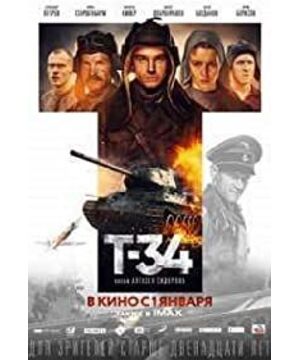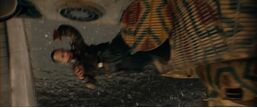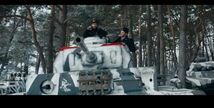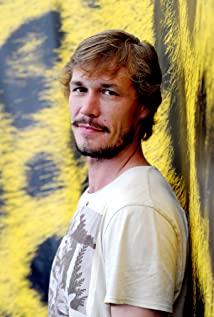Commonly used pen name: Führer Guard
Lived in Europe for 8 years. He is proficient in German and loves the history of World War II and modern warfare. Since 2000, he has worked on military history websites such as "The Art of War", "German Military Center", and sonicbbs, as well as "Assault" and "War History Research". 》Published many original articles and translated many German films and TV series with Chinese subtitles
If you are interested in military history and military-themed movies, please pay attention to my headline today: The Twilight Study of the Gods
WeChat public account: The Twilight Study of the Gods (or search for "WarArtStudy") or scan the QR code of the official account below:
The future will bring more little-known historical details.
Reprinting without permission is declined
Last weekend, the Russian war blockbuster "Hunting T-34" was officially screened in domestic theaters. I believe that many military fans have already seen it.
The film was filmed for two months and was filmed in the Moscow Region and the Czech Republic. It cost 600 million rubles. It premiered in Russia on New Year’s Day in 2019. After the screening, it achieved great commercial success, with a total box office of 2.2 billion rubles. (Approximately US$32 million), became the second highest grossing film in Russian history, and won three awards for best director, best adapted screenplay and best visual effects in this year's Golden Eagle Awards.
Russian version poster
Japanese poster
Chinese poster
This film is full of a lot of computer stunts "bullet time" shots, it is an out-and-out cool film
But since the background is set during World War II, it will inevitably be inextricably linked to real history, and as a pure commercial film, there will inevitably be a stage of interpretation attached to it, as the title of "Film and Reality" Series, this article will try to verify the fragments in the film that are consistent or contradictory with history.
Battle
The first battle movie scenes, historical background should be in late 1941 during the battle of Moscow in mid-October沃洛科拉姆Gdansk (Volokolamsk) battle.
The city is located west of Moscow. On October 15th, Panzergruppe 4, the 46th Army 2nd Armored Division of the German Central Army Group (Panzergruppe 4), and the 5th Army 35th Infantry Division launched the main attack, and the 46th Army’s 11th Armored The division is double-teamed from the south. In the film, the German No. 3 tanks are all painted with the ghost badge of the 11th Panzer Division, which shows that this battle is an offensive on the south side.
In real history, in August 1940, the 11th Armored Division was expanded from the 11th Rifle Brigade (11. Schützen-Brigade, formed in December 1939).
The 11th Rifle Brigade was awarded the title of "Gespenster" because of its remarkable circuitous maneuvers in the French campaign.
After the expansion and rename, this title was also passed on to the 11th Armored Division. Therefore, the division also has the well-known ghost emblem in addition to the nickname "Kaffebohne" (Kaffebohne) and the standard badge on the outer circle.
However, the ghost badge on the tank is painted on the sides and rear, with only the badge on the front. This is different from the form presented by the movie.
Before the beginning of 1942, the tank tactical numbers of the 11th Armored Division were all double digits (platoon/vehicle), with the prefix (company) omitted; the diamond symbol was the logo of the 1st Battalion of the 15th Armored Regiment.
However, it can be seen from historical photos at the time that only the first snow fell in Volokolamsk in late October, and the vehicles of the 11th Armored Division still maintained the existing iron gray monochrome paint, and no winter snow camouflage was applied; there was no snow for the personnel. Camouflage dress. What the movie presents is not in line with historical facts.
The 316th Division of the Soviet 16th Army Infantry, defending Volokolamsk, retreated due to heavy casualties for two weeks after a fierce battle with the Germans. The city of Vau also fell on October 27.
On November 16, the division's defense line in Dubosekovo, a village 10 kilometers southeast of Vau, was breached by the German 2nd Armored Division, and its 1075th Infantry Regiment was completely destroyed.
The defeat of the 316th Division threatened the flanks of the 16th Army, and Lieutenant General Rokosovsky, then commander of the Army, was forced to request the Base Camp Reserve to mobilize the reserve of the 78th Siberian Infantry Division to the battlefield.
The soldiers of the 78th Division were forced to retreat three days after their arrival. However, due to Soviet resistance and weather conditions, the advancement of the German forces slowed down and the battle gradually fell into a stalemate.
But the next day it was promoted by the news media, but it became the heroic deed of the remaining 28 officers and soldiers of the 4th company of the 2nd Battalion of the regiment fought and destroyed 18 German tanks, and finally all sacrificed heroically.
On the same day, the 316th Infantry Division was also awarded the title of Guards for its outstanding performance in preventing and delaying the German offensive at the Battle of Vau, and was renamed the 8th Guards Infantry Division.
On November 18, the division commander, Major General Ivan Vasilyevich Panfilov, was attacked by German mortars during an interview with journalists at the battlefield command post in Gusenevo, a village 15 kilometers northeast of Dubosekovo. , Because the interview site was empty and uncovered, he was hit by shrapnel and was killed in action. Major General Panfilov was promoted to Hero of the Soviet Union the following year; the division was also named after him.
However, the "Twenty-eight Guards of the Panfilov Division" (Двадцать восемь гвардейцев дивизии Панфилова), which posthumously awarded the title of Hero of the Soviet Union, was confirmed as a fictional story after investigation by the Soviet government in 1948.
In fact, in Dubosekovo’s offensive that year, the German army did not suffer any major losses; 6 of the 28 Soviet soldiers who claimed to have sacrificed themselves also survived, and they all lived incognito until the end of the Second World War.
In June 2015, Sergei Mironenko, the director of the State Archives of Russian Social and Political History, was interviewed and publicly stated that the Panfilov 28 Guards was a non-existent myth. he
His remarks were strongly condemned by Russian Minister of Culture Vladimir Medinsky. But soon after, the National Archives of Social and Political History published the results of the investigation of Soviet military prosecutors in 1948 on the Internet, and the conclusion was that the reporter of the "Red Star" fabricated the details of the story.
On March 16, 2016, Sergei Mironenko announced that he had resigned because he reached the legal retirement age (65 years old). At the same time, he denied that the resignation was based on external pressure. The real purpose is to "focus on scientific research." Work" and said: "If this is not my decision, do you think I will be silent? […] There is nothing to worry about about my resignation."
In October of the same year, the Minister of Culture Medinsky defended the 28 Guards of Panfilov, saying: “Even if this story is fabricated from beginning to end; even if there is no such person as Panfilov; even if the whole thing is not at all Whether it exists, it is still a sacred legend that cannot be violated. Anyone who can do this is an ugly scum."
Tanks in the film
According to the square machine gun nozzle on the front of the car body and the form of the driving wheels and the commander's top tower, the German No. 3 tank presented in the front end of the movie is the J-type that was mainly mass-produced in 1941.
The front armor of the No. 3 J was increased to 50mm, and the side armor was increased to 32mm. Historically, it appeared in a large number of battlefields in North Africa and the Eastern Front. A total of 2,616 vehicles were produced, which is the largest production model of the No. 3 tank.
Based on Barbarossa’s actual combat experience in encountering Soviet T-34 medium tanks and KV heavy tanks, the No. 3 tank J, which was originally equipped with a 5 cm KwK 38 L/42 tank gun, was replaced with a long body of 5 cm KwK in December 1941. 39 L/60 tank gun, and gradually replaced the existing variants, and was given the title of L-type. The long-body No. 3 tank that appeared in the movie was not yet available at the time of the Battle of Volokolamsk.
The Leopard tank that appeared in the latter part of the film became the biggest highlight of the film. It is also one of the few fragments in film history where the main German tank is the protagonist. The model presented in the film is the late G-type produced after late September 1944. Production type.
The appearance features that are gradually added during the production process include the elimination of the observation hole in the front of the driver's seat to simplify production and increase the strength of the front of the armor, the upper side of the car body no longer has a step feature, and the exhaust fan of the left engine is increased to facilitate the battle room linked with the engine. The layout of the heating system (Kampfraumheizung), the shielded gun shield to prevent the bombs from directly hitting the top armor of the front of the car body, and the installation of the exhaust pipe flame suppressor (Flammenvernichter) which is conducive to night battles.
The Leopard tank in the movie has two late-stage mass-produced features, the left-side engine exhaust fan tower and the nodded gun shield, and it is also coated with anti-magnetic coating (Zimmerit). However, the driver's observation hole on the front of the armor should not exist.
On September 10, 1944, the anti-magnetic coating was abolished in the entire army; the left side engine exhaust fan tower became the factory standard equipment on September 22 of the same year.
The coexistence of exhaust fan towers and anti-magnetic coatings is extremely rare. The Panther tank that was destroyed on the Western Front on September 23, 1944 in the picture below is presumed to be used to test the exhaust before the anti-magnetic coating was abolished in August. The pre-production batch of G-type late-stage fan tower.
In any case, the capped gun shields that began to be equipped in October of the same year should not coexist with the antimagnetic coating. In addition, the Panther G-type tank has cancelled the observation hole in front of the driver's seat, so naturally it will not be penetrated by the protagonist's T-34 aiming here as in the movie. These are all flaws in film research.
Another eye-catching detail in the film is the FG1253 "Sperber" night vision device (Fahrgerät 1253 "Sperber") on the Leopard tank. The device includes a 200-watt infrared headlight and an infrared receiver/aim. The device can "see" and convert infrared wavelengths into visible light.
However, there is currently available information. The only unit that has been put into actual combat is the 1st Company of the 29th Armored Regiment. It is believed that there are 10 Leopards equipped with FG1253 equipment for the commander and driver.
The captain can switch from normal periscope mode to night vision mode at any time, and there is also an infrared sight on the left side of the driver.
When the commander turns on the infrared filter, he can see the ground through the commander's spotlight or the light cast by the "owl" on sd.kfz 251. In addition, the "Münchenberg" armored division and the "Klausewitz" armored division have also been equipped with a small number of night warfare leopards.
The Panther tanks of the SS have never had a credible record of being equipped with infrared sights in history.
The front armor of the Panther tank in the film is painted with the emblem of the 12th SS Panzer-Division "Hitlerjugend".
The division continued to deploy on the Western Front after its establishment in Belgium on October 30, 1943. It participated in the Battle of Normandy from early June 1944 to the "Unternehmen Wacht am Rhein" operation (Unternehmen Wacht am Rhein) that ended in late January of the following year. Battle of the Bulge.
In February 1945, Fang was transferred to the Army Group Southern and went to Hungary to fight the Soviet Army on the Eastern Front. He participated in the last strategic counterattack "Spring Awakening" in the Second World War launched by the Germans in the Lake Balaton region in March.
The recovered T-34-85 captured in the latter part of the movie is expected to be driven by Soviet prisoners of war and used as a live target for German tank shooting training. The POW camp here is the Außenlager S III concentration camp (Zwangsarbeitslager Ohrdruf), located about 145 kilometers southwest of Leipzig in central Germany.
The area has been receiving Soviet prisoners of war since the end of 1941, but it was only taken over by the SS in the autumn of 1944. On April 2, 1945, due to the approach of the Allied forces, the detainees were driven by SS members to the Buchenwald Concentration Camp (Buchenwald) 51 kilometers southwest. During the process, more than 1,000 prisoners were killed. According to records, members of the Hitler Youth League also Participated in this death march.
The Hitler Youth League originated from the Jugendbund der NSDAP (Jugendbund der NSDAP) founded in 1922, and was renamed in July 1926. Although the organization has routine military training, its Patrol Service (HJ Streifendienst) also serves as a training unit for the 12th SS Armored Division, but it is not a military unit, nor is it under the jurisdiction of the SS.
In real history, the 12th SS Panzer Division has never been deployed in the Oldruf area, nor has it participated in the incidents related to this concentration camp. Therefore, the tank chase plot in the latter part of the movie is entirely fictional.
In terms of historical background, the events in the latter part of the movie should have occurred between October and early December 1944, that is, from the start of production of the Panther G-type late mass production model to the start of the Watch Rhine operation. There is no snow on the ground in the scene, which is consistent with the situation that snow will only fall in the Aldruf area in January and February.
At this time, the 12th SS Panzer Division, which suffered heavy losses during the Battle of Normandy, has retreated to the Eifel mountain area on the border of Luxembourg in western Germany, and then moved to Nienburg/Weser, 50 kilometers northwest of Hanover. To make up, the two places are 380 kilometers and 260 kilometers away from Aldruf, respectively. The division was once again deployed in the Eifel Mountains on the Belgian border on December 13 of the same year, preparing to participate in the Watch Rhine operation.
When the 12th SS Panzer Division was formed, it was based on the senior sergeant officers transferred from the 1st SS Panzer Division (Leibstandarte SS Adolf Hitler), so many tactical details were also inherited. .
For example, the last code in the tank turret tactical number does not start with 1, but the serial number starting with 5 adopted by the Guard and Flag Division since its formation; and this coding method has not changed until the Germans were defeated.
Therefore, car No. 111 and Car No. 112 seen in the movie are not the division's coding method. And the camouflage was not the usual style of German armored vehicles at the time.
Characters
The German protagonist Klaus Jäger was the captain of the 11th Armored Division of the Wehrmacht in October 1941, and the captain of the SS Banner of the 12th Armored Division of the SS in October 1944, that is, the rank of colonel. Examples are rare in the German army.
However, in terms of his appearance, he is close to Max Winscher, the first commander of the 12th SS Armored Regiment of the division in history.
However, Max Winscher has been in the SS since joining the army and has no experience in the army, and he was captured by the British army as early as the Falaise encirclement on August 20, 1944.
There is also a big figure in the play, Guderian, the director of the German armored forces, but his presence is quite weak.
Guderian and Jaeger also appeared in the final exercise scene together, but once again served as a decoration
In real history, Guderian did visit the Beverloo training ground (Truppenübungsplatz Beverloo) in Belgium on February 7, 1944, to inspect the Hitler youth division in training.
In the picture above, it is Max Winscher, the commander of the 12th SS Armored Regiment, who is giving orders on the Leopard control tower. Standing in front of the tank with his back facing the camera, from left to right are:
General Leo Freiherr Geyr von Schweppenburg (Leo Freiherr Geyr von Schweppenburg), then commander of the German Armored Group (berbefehlshaber Panzergruppe West), Guderian, Chief of Staff of the 1st SS Panzer Corps SS superior commander Fritz Kraemer (Fritz Kraemer) and Hitler's youth division commander SS superior commander Fritz Witt (Fritz Witt)
Unlike the highest-ranking officer in the movie, only Jaeger, in real history, the commander of the 1st SS Panzer Corps also appeared in the training ground to explain to Guderian, standing in the picture Guderian’s left is Hitler’s Youth Division’s 26th SS Panzergrenadier Regiment 1st Battalion Battalion Commander SS Assault Battalion Captain Bernhard Krause (Bernhard Krause)
Turret basket
This film presents a large number of scenes inside the tanks of the Soviet and German armies, which greatly enhances the audience’s sense of presence
Here is an introduction to the turret basket of a German tank. This facility can provide the crew in the tank turret (usually the commander, shooter and loader, but the T-34/76 commander and shooter) a base plate that can rotate with the turret.
The German army is equipped with turret baskets on the No. 4 tank and all subsequent tanks; the H-type produced after May 1941 for the three-tank has become standard equipment at the factory, and the existing E, F, and G models are also installed. . None of the Soviet tanks in World War II had a turret basket.
The turret gondola can increase the rate of fire when the tank is in contact with the enemy and provide a safer operating environment for the crew in the turret.
Even if there is no turret basket, the occupants in the turret still have small chairs welded on the inner wall of the turret to sit on, so they can also rotate with the turret.
However, in actual combat, the loader must stand on the fixed bottom plate of the chassis, hold several kilograms of shells in the narrow turret and move with the turret rotating, so as to grasp the direction of the barrel to load the shells; at the same time, they must also be in the process of selecting and transporting the shells. Always pay attention to avoid being injured by the rotating tank gun structure or the retreat action after launching.
In addition, tanks such as T-34/76 without a turret gondola usually have very small internal space. The shells are mainly stored in the shell box on the chassis, and the closed shell box cover serves as the bottom plate. The loader has to open the bullet box to load the bullet, and remember to cover it again, otherwise he has to be careful not to trip over the opened bullet box.
The T-34/76's impressive electric turret gyration system can reach a gyration rate of 37 degrees per second, so it only takes 10 seconds for the turret to rotate one circle. The sudden selection of high speed (gunner control) coupled with the harsh operating environment, the pressure of the loader can be imagined, and the rate of fire cannot be increased.
In actual combat, the T-34/76 can fire about 3-5 rounds per minute, but the rate of fire of the German No. 3 and No. 4 tanks can reach more than 10 rounds per minute.
The turret basket can avoid the nightmare of these loader, and can stack preselected shells on the bottom plate that rotates with the turret, which greatly increases the rate of fire in the early stage of engagement.
View more about T-34 reviews











